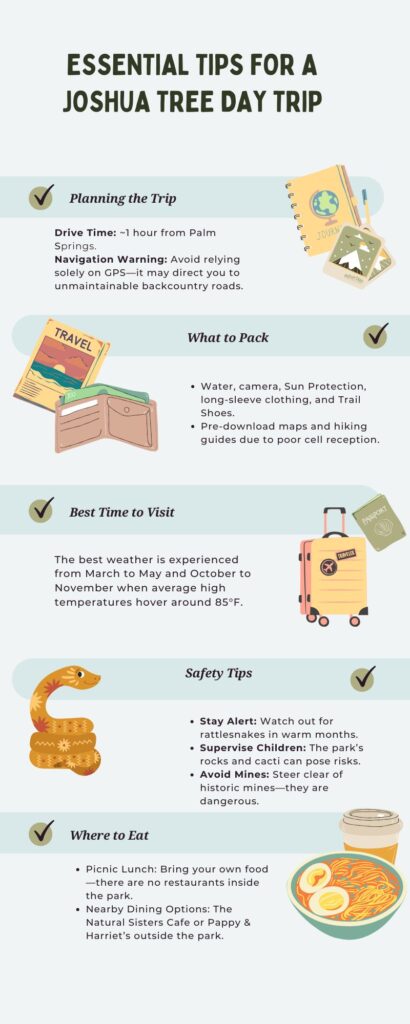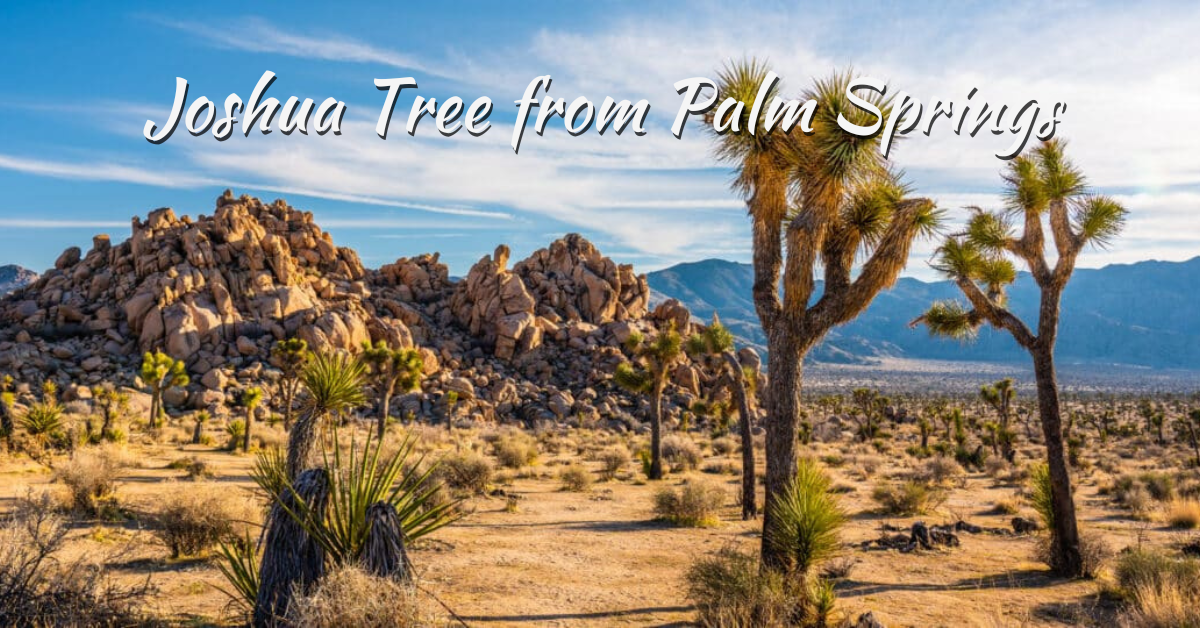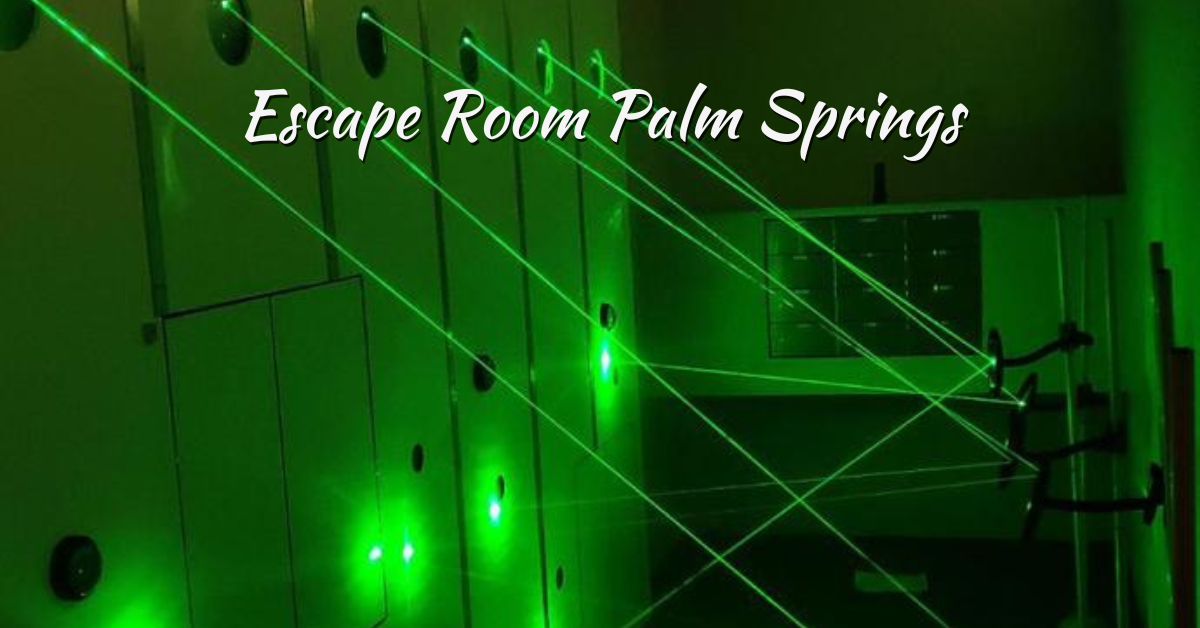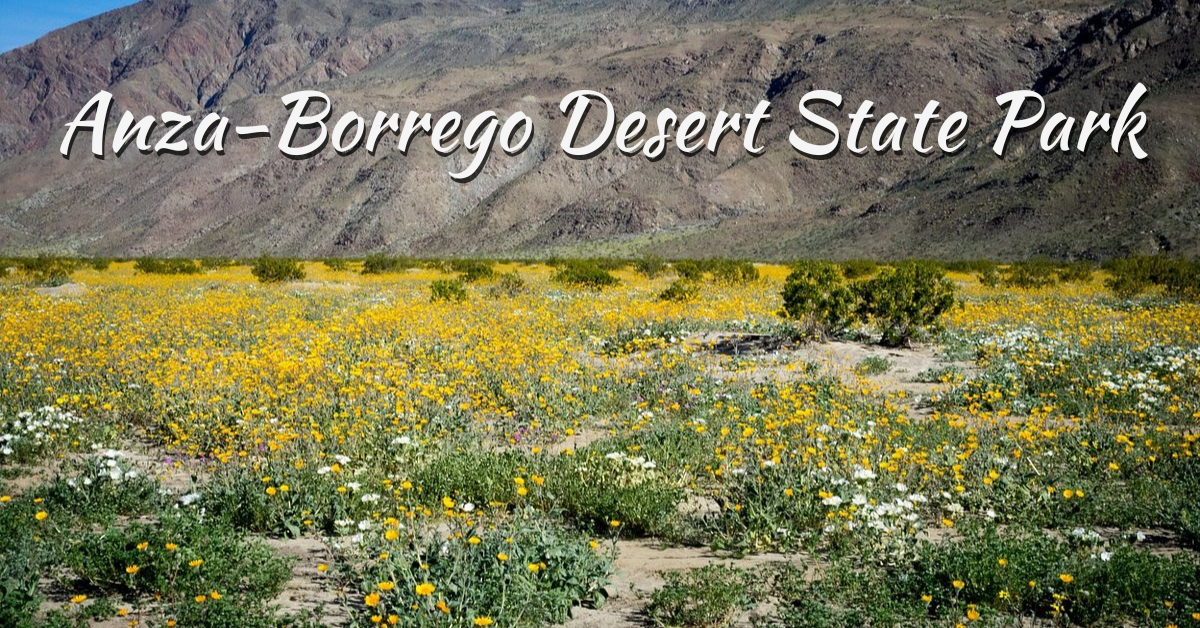Joshua Tree National Park is a short drive from Palm Springs, a desert oasis. Planning a trip from Palm Springs to experience the unique beauty of both destinations.
This well-known park offers a breathtaking combination of rock formations, desert panoramas, and various plant and animal life.
It is named for the distinctive Joshua Trees that dot its expansive landscape.
A great way to get up close and personal with the marvels of the desert is to take a day trip to Joshua Tree National Park from Palm Springs.
Taking a trip from Palm Springs to Joshua Tree will offer you the chance to witness incredible landscapes and diverse wildlife.
Come with us as we explore this captivating national park’s fascinating sites and things to do.
The drive from Palm Springs to Joshua Tree is a journey worth taking for its stunning views and unique desert experiences.
Prepare yourself for a day filled with adventure and exploration.
The Journey Begins: Easy Drive to Joshua Tree National Park From Palm Springs
Joshua Tree National Park is easily accessible for a day trip from Palm Springs. The drive takes around one hour.
To enhance your journey from Palm Springs to Joshua Tree, make sure to pack plenty of water and snacks for the road.
As you leave Palm Springs, the surrounding desert environment gradually opens before you, preparing you for the adventure ahead.
Entering Joshua Tree: Navigating to the West Entrance
Begin from the park’s west entrance and proceed through its south entrance before returning to Palm Springs.
Don’t forget to capture the stunning views during your trip from Palm Springs to Joshua Tree for lasting memories.
- Proceed from N. Indian Canyon to I-10.
- Go to Sage Ave. in Yucca Valley by taking CA-62 E/29 Palms Hwy.
- To reach the West Entrance, take Quail Springs Road, Alta Loma Road, and Yucca Trail.
Do not rely on GPS for instructions to and from Joshua Tree National Park!
Remember that the trip from Palm Springs to Joshua Tree can vary in time based on traffic and weather conditions.
Sometimes, car navigation systems attempt to take you onto backcountry routes that may be unusable for your car due to ruts or soft sand.
Stopping at various points along the way from Palm Springs to Joshua Tree can turn your drive into an unforgettable adventure.
The journey from Palm Springs to Joshua Tree promises scenic views and the opportunity to discover unique desert landscapes.
First Stop: Visit the Joshua Tree National Park Visitor Centers
When you first arrive in Joshua Tree National Park, we advise you to stop at one of the visitor centers.
Your trip from Palm Springs to Joshua Tree is a must-do for anyone looking to connect with nature.
Accessible from the northern entrance of the park, the Oasis Visitor Center offers insightful details about the park’s geology, fauna, and hiking routes.
Situated next to the west gate, the Joshua Tree Visitor Center features informative displays and exhibits on the natural and cultural history of the surrounding area.
Don’t rush; take your time to appreciate the scenic drive from Palm Springs to Joshua Tree.
Ideal Joshua Tree Itinerary: A Perfect Day from Morning to Evening

Here is an itinerary that you can follow for an amazing trip to Joshua Tree National Park.
- Morning
Wake Up Early: To avoid the heat and the crowds, depart Palm Springs by 7 am. The trip is beautiful in and of itself, providing a backdrop for your day.
Hike: Go on a hike in the early morning. It is recommended to take the Hidden Valley route. It offers a simple one-mile circle with some reasonably unique rock formations and Joshua trees. It’s a fantastic way to begin your park day.
Though it’s a little more complicated, Ryan Mountain offers panoramic views for those seeking more effort. You get to decide!
- Afternoon
Eat & Explore Lunch: Refuel with wholesome fare at The Natural Sisters Cafe following your journey.
Go on Another Hike: After lunch, explore the Barker Dam Nature Trail. The hike is reasonably easy and ends in a historic dam. It frequently has a small pool of water surrounded by interesting rock formations and petroglyphs.
- Late afternoon
Scenic Drive: If you prefer to enjoy Joshua Tree’s splendor from the luxury of your vehicle, you may drive down Park Boulevard to see breathtaking views of the desert.
It’s essential to stop briefly at the Cholla Cactus Garden Nature Trail, which is roughly 12 miles south of the northern park entrance.
The teddy bear cholla is the main feature of the terrain along this trail.
Pioneertown: On your way back, stop by Pioneertown. A fantastic way to end the day is to visit this old movie set turned live town, which offers a glimpse into the Old West.
Eat an early dinner at Pappy & Harriet’s if you have the time.
- Evening
Your adventure from Palm Springs to Joshua Tree will be filled with breathtaking sights and unique experiences.
As you return to Palm Springs, enjoy the shifting hues of the desert, capping off a full day of discovery and excitement.
Essential Tips for Your Palm Springs To Joshua Tree Day Trip

Best Time to Visit Joshua Tree From Palm Springs
The best weather is experienced from March to May and October to November when average high temperatures hover around 85°F.
These months are ideal for trekking and exploration, and there’s the added advantage of wildflower blossoms in April!
Entrance Price
It costs $30 for a seven-day pass. The Private Vehicle Pass is the most popular fee. Groups might benefit from this pass since it covers every passenger in the car.
There are days when admission is free. These are:
- MLK Day
- the opening day of National Park Week
- Juneteenth
- the Great American Outdoors Act anniversary
- National Public Lands Day
- Veterans Day
Navigation and Cell Service
Joshua Tree has a terrible cell reception situation.
Research hiking trails in advance and download maps on your phone to ensure you get all the locations.
Bring your food
It’s advisable to pack a picnic lunch. There are no food joints available inside.
Luckily, several dining options exist in the surrounding villages just outside the park.
Be Careful
Avoid going near abandoned mines. Indeed, this area contains historic mines. Be cautious around them as they may pose a threat.
Keep an eye on Children
Watch over your children! There are many cacti, and nearly all of the rocks are climbable. Thus, there are many opportunities for them to get injured.
Watch Out!
Particularly in the spring and summer, take care where you place your hands and feet! During these months, snakes are most active. The park is home to six different species of rattlesnakes, which is unfortunate.
What to Pack for Your Joshua Tree Adventure
- Water bottles or hydration packs: It’s essential to stay hydrated in the desert heat, which is no joke. Carry a lot of water bottles with you.
- Sunscreen: It is strongly advised to use sunscreens. You can get sunburn or tan if you are not careful.
- A hat: A baseball cap with UPF50+ sun protection is a great choice, or you can wear one when hiking.
- Clothes: For sun protection wear a breathable hiking tee or a long-sleeve top with comfortable pants.
- Shoes: It’s imperative to have a decent pair of trail runners! We will need the right amount of flexibility, grip, and support for trekking and strolling.
- Pre-downloaded Electronic Handbooks: Download maps before travel. To simplify things even more, you can even go on a self-guided tour of Joshua Tree!
- Camera: Don’t forget to pack your camera, to capture some amazing pictures during your travel.
How Far is Joshua Tree from Palm Springs?
How far is Joshua Tree from Palm Springs? The good news is that Joshua Tree National Park is a short drive from Palm Springs, making it perfect for a day trip into this natural wonder. The trip from Palm Springs to Joshua Tree National Park is straightforward and offers beautiful desert landscapes along the way.
Joshua Tree to Palm Springs is a journey many travelers make in a single day, allowing them to enjoy both destinations during their vacation. Depending on which entrance you choose, your journey from Palm Springs to Joshua Tree will vary slightly in distance and time.
How far is Palm Springs from Joshua Tree? The West Entrance near Joshua Tree Village is approximately 33.8 miles northeast of Palm Springs, typically taking about 45 minutes to an hour to reach by car. For those heading to the North Entrance at Twentynine Palms, the drive from Joshua Tree National Park to Palm Springs extends to around 50 miles and usually requires about 1 hour and 7 minutes of travel time.
The South Entrance at Cottonwood Spring is situated near Interstate 10, making Joshua Tree from Palm Springs accessible from a different angle, approximately 60 miles east with a driving time of about 1 hour and 14 minutes. Your adventure from Palm Spring to Joshua Tree will follow CA-62, a well-maintained highway that provides direct access to the park’s entrances.
Palm Springs to Joshua Tree National Park is a route traveled by thousands of visitors each year who come to experience the unique desert ecosystem.
How far from Palm Springs to Joshua Tree National Park? The distance varies by entrance, but the closest point is just about 34 miles away, making it an easy half-day or full-day excursion.
As you travel from Joshua Tree National Park from Palm Springs, you’ll be treated to expansive desert vistas and stunning mountain backdrops that prepare you for the wonders ahead.
The relatively short distance from Palm Springs to Joshua Tree makes this national park accessible even for visitors with limited time in the area.
Joshua Tree National Park to Palm Springs is a journey that takes you from rugged wilderness back to resort luxury, offering the best of both worlds in a single day. Whether you’re planning a trip from Palm Springs to Joshua Tree National Park or returning from Joshua Tree to Palm Springs, the scenic drive is part of the adventure itself.
Joshua Tree Tours from Palm Springs
Enhance your trip from Palm Springs to Joshua Tree by joining one of the many guided tours available in the area. Adventure Hummer Tours offers daily excursions in air-conditioned Hummers, allowing you to explore iconic spots within the park while learning about its unique geology and history.
Your journey from Palm Springs to Joshua Tree becomes even more memorable with Joshua Tree Excursions, a private guiding service that provides day hikes, camping trips, and night sky presentations. Red Jeep Tours offers another exciting way to experience the magic of Joshua Tree with private tours that traverse the park’s diverse landscapes.
Taking a guided tour for your trip from Palm Springs to Joshua Tree enhances the experience with expert knowledge about the park’s natural features.
These tours ensure a seamless journey from Palm Springs to Joshua Tree, allowing you to fully immerse yourself in the park’s splendor without concerns about navigation or planning. Tour guides often know the best spots for photography during your adventure from Palm Springs to Joshua Tree, helping you capture unforgettable memories.
Whether driving independently or joining a guided excursion, the proximity of Joshua Tree National Park to Palm Springs makes it a must-visit destination.
Your day trip from Palm Springs to Joshua Tree can be customized to suit your interests, from rock climbing to wildlife watching or simply soaking in the unique desert atmosphere. Remember to book your tour in advance, especially during peak seasons, to secure your spot for an unforgettable journey from Palm Springs to Joshua Tree.
Incase you’re planning this trip and haven’t decided on an accommodation in Palm Springs, do check out Spirit of Sofia!
FAQs – Palm Springs to Joshua Tree Day Trip
1. How long does it take to drive from Palm Springs to Joshua Tree?
Make your journey from Palm Springs to Joshua Tree one to remember by taking lots of photos along the way.
The drive from Palm Springs to Joshua Tree National Park takes approximately one hour. The journey is scenic and offers a gradual transition from the oasis environment of Palm Springs to the expansive desert landscape of Joshua Tree.
2. What is the best route to take from Palm Springs to Joshua Tree National Park?
To reach Joshua Tree National Park, start from Palm Springs and head north on N. Indian Canyon. Take I-10 to CA-62 E/29 Palms Hwy, then proceed to Sage Ave. in Yucca Valley. From there, take Quail Springs Road, Alta Loma Road, and Yucca Trail to the West Entrance. Note that GPS navigation might direct you to unsuitable backcountry routes, so use caution.
3. Where should I go first when I arrive at Joshua Tree?
It’s recommended to start at one of the visitor centers. The Oasis Visitor Center, located at the northern entrance, provides valuable information on the park’s geology, fauna, and hiking trails. The Joshua Tree Visitor Center near the west gate offers exhibits on the park’s natural and cultural history.
4. What is a suggested itinerary for a day trip to Joshua Tree?
- Morning: Depart Palm Springs by 7 am to avoid heat and crowds. Hike the Hidden Valley route for a simple, scenic walk or tackle the more challenging Ryan Mountain for panoramic views.
- Afternoon: Enjoy lunch at The Natural Sisters Cafe and then hike the Barker Dam Nature Trail, which features interesting rock formations and petroglyphs.
- Late Afternoon: Take a scenic drive along Park Boulevard and visit the Cholla Cactus Garden Nature Trail. Consider stopping by Pioneertown for a taste of the Old West and dine at Pappy & Harriet’s if time allows.
- Evening: Return to Palm Springs and enjoy the changing desert colors.
5. What is the best time of year to visit Joshua Tree?
The best times to visit are from March to May and October to November, when temperatures are mild, averaging around 85°F. Wildflower blooms in April add extra beauty to the park during spring.
6. Is cell service available in Joshua Tree?
Traveling from Palm Springs to Joshua Tree is an experience that connects you to nature in a profound way.
Cell reception in Joshua Tree is limited. It is advisable to research hiking trails and download maps on your phone before your visit to avoid getting lost.
7. What should I pack for a day trip to Joshua Tree?
Pack plenty of water bottles or a hydration pack, sunscreen, a hat for sun protection, breathable hiking clothes, sturdy trail shoes, pre-downloaded maps or electronic guides, and a camera to capture your adventure.
Your drive from Palm Springs to Joshua Tree will be more enjoyable if you listen to some great music along the way.
8. What safety precautions should I take in Joshua Tree?
Avoid abandoned mines, watch over children to prevent injuries from cacti and climbable rocks, and be cautious of rattlesnakes, particularly during warmer months.
The drive from Palm Springs to Joshua Tree offers numerous opportunities for exploration and discovery.
Plan your day wisely to make the most of your trip from Palm Springs to Joshua Tree.
Make sure to check the weather before your trip from Palm Springs to Joshua Tree for a more enjoyable experience.
Immerse yourself in the serenity of your journey from Palm Springs to Joshua Tree.
Remember to take your time and enjoy the journey from Palm Springs to Joshua Tree, as there is much to see.
Pack your essentials and get ready for a thrilling trip from Palm Springs to Joshua Tree.
Prepare for an unforgettable experience when traveling from Palm Springs to Joshua Tree, filled with natural beauty.











